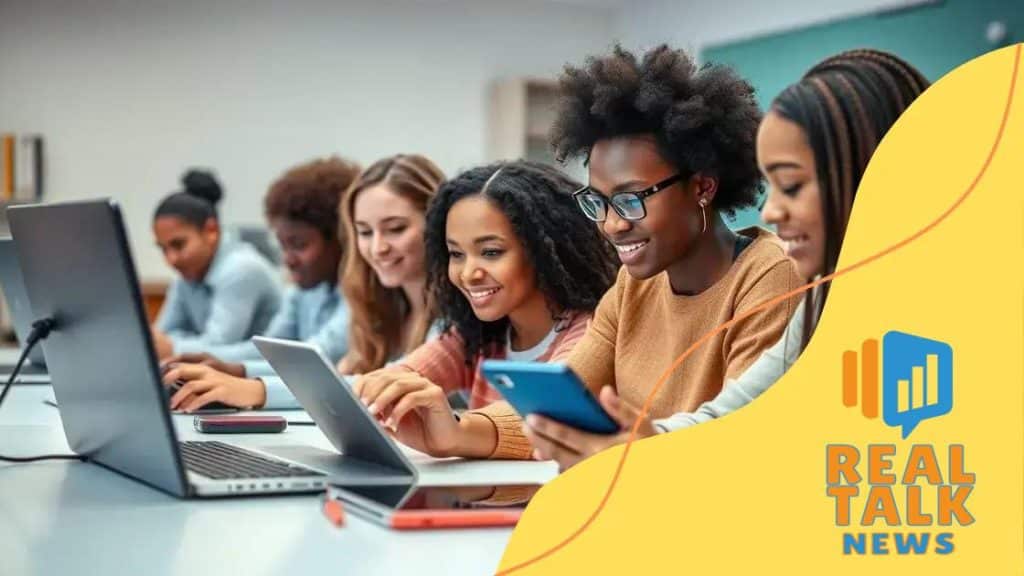The impact of virtual classrooms on student collaboration

The impact of virtual classrooms on student collaboration is substantial, enhancing communication, fostering teamwork, and improving problem-solving skills while presenting challenges like technology issues and social isolation.
The impact of virtual classrooms on student collaboration is significant. As education shifts online, how do these environments shape teamwork among students? Let’s explore this dynamic.
Understanding virtual classrooms
Understanding virtual classrooms is essential in today’s educational landscape. These digital spaces have transformed traditional learning, making it more flexible and accessible.
What are Virtual Classrooms?
Virtual classrooms are online environments where teachers and students interact remotely. They use various tools to facilitate learning, such as video conferencing, online quizzes, and discussion boards. This setup allows students to collaborate easily, regardless of their physical location.
Key Features of Virtual Classrooms
- Interactive Learning: Students can engage in real-time discussions and activities.
- Accessibility: Learners can join from anywhere, accessing course materials at their convenience.
- Multimedia Integration: Teachers can use videos, presentations, and interactive content to enhance lessons.
- Continuous Assessment: Online quizzes and assignments help track student progress.
The use of technology in these classrooms encourages participation and feedback. Integrating interactive tools like polls and breakout rooms leads to a more engaging learning experience. Educators can create a sense of community, as students feel more connected in smaller group discussions.
Benefits of Virtual Classrooms
Beyond just convenience, virtual classrooms offer numerous benefits. For instance, they cater to diverse learning styles and needs. Students who may feel shy in physical classrooms may find it easier to participate online.
Furthermore, virtual classrooms allow for a variety of resource sharing. Educators can easily share articles, videos, and other materials that enrich the learning experience.
Incorporating different teaching methods is also simpler in a virtual environment. Instructors can switch between lectures, group work, and independent study sessions seamlessly.
Key features that promote collaboration
Key features that promote collaboration in virtual classrooms can enhance the learning experience significantly. These features create an interactive environment that encourages teamwork among students.
Real-Time Communication
One of the most crucial aspects is real-time communication. Video conferencing tools allow students to discuss ideas as they arise. This immediacy helps them to engage more actively and work together effectively.
Group Work Tools
Virtual collaboration also benefits from dedicated group work tools. Features such as breakout rooms enable small groups to collaborate on projects without distractions. This setup mimics in-person teamwork, fostering connections as students brainstorm and solve problems together.
- Breakout rooms for focused discussions.
- Shared documents for simultaneous editing.
- Collaborative whiteboards for visual brainstorming.
Moreover, the integration of cloud storage drives ensures that all resources are accessible anytime and anywhere. This ease of access supports students in sharing information and collaborating outside scheduled class times.
Interactive Learning Activities
Engagement can be further enhanced through interactive activities. Online quizzes and polls actively involve students in their learning process. These activities not only keep students engaged but also allow for instant feedback, which is crucial for effective collaboration.
The incorporation of games and simulations in virtual classrooms can also create excitement and promote teamwork. Students are more likely to collaborate and support each other through friendly competition.
Benefits of collaborative learning online

The benefits of collaborative learning online are numerous. This approach helps students develop essential skills while fostering a sense of community, even in a virtual environment.
Enhanced Communication Skills
One major advantage is that it enhances communication skills. Students learn to express their ideas and share feedback with peers. This practice builds confidence and improves their ability to articulate thoughts clearly.
Diverse Perspectives
Working in groups brings together various viewpoints. Students interact with others from different backgrounds and cultures, which enriches their learning experience. Exposure to diverse perspectives encourages critical thinking and broadens understanding.
- Increases creativity through idea exchange.
- Promotes empathy and appreciation for differences.
- Encourages a more comprehensive understanding of topics.
Additionally, online collaborative learning promotes responsibility among students. When working in groups, each member is accountable for their tasks, leading to improved time management and organizational skills.
Improved Problem-Solving Abilities
Collaborative learning also enhances problem-solving skills. When faced with challenges, students work together to find solutions. This collaborative approach fosters resilience and adaptability, important traits in today’s world.
Not only do students learn from each other, but they also gain the ability to approach problems from multiple angles. This skill set is vital for academic success and future career opportunities.
Challenges faced in virtual collaboration
Challenges faced in virtual collaboration can impact students’ learning experiences. While online environments offer many benefits, they can also present obstacles that hinder effective teamwork.
Communication Barriers
One significant challenge is communication barriers. Misunderstandings can arise due to the lack of nonverbal cues in virtual settings. When students rely solely on text and video, messages may be misinterpreted.
Technology Issues
Another hurdle involves technology issues. Poor internet connection or software glitches can disrupt collaboration efforts. Students might feel frustrated when they face technical difficulties during important discussions or activities.
- Inconsistent access to devices can limit participation.
- Learning new tools can be overwhelming for some students.
- Privacy concerns may lead to reluctance in sharing information.
Moreover, time zone differences can hinder collaboration for international student groups. Scheduling meetings that accommodate everyone can be challenging, leading to missed opportunities for interaction.
Social Isolation
In addition to technical challenges, social isolation is a common issue. Students in virtual classrooms may feel disconnected from their peers. This sense of isolation can affect motivation and engagement, especially in collaborative tasks.
To combat these challenges, it’s crucial for educators to foster a supportive environment. Encouraging open communication and providing clear instructions can help students navigate the complexities of virtual collaboration.
Strategies to enhance teamwork in virtual settings
Strategies to enhance teamwork in virtual settings can significantly improve students’ collaborative experiences. By applying effective methods, educators can create a more supportive and engaging online learning environment.
Clear Communication Guidelines
Establishing clear communication guidelines is essential. Setting expectations for how students should communicate helps reduce misunderstandings. Instructors can encourage the use of video for meetings, as this fosters better engagement and connection among team members.
Defined Roles and Responsibilities
Assigning defined roles and responsibilities can also strengthen teamwork. When each member knows their job, it helps streamline tasks and boosts accountability. It is important to rotate roles in projects so that everyone gains varied experience.
- Facilitator to lead discussions.
- Recorder to take notes and summarize meetings.
- Presenter to share group findings.
In addition, using collaborative tools can enhance teamwork. Platforms that allow document sharing and collaborative editing enable students to work together more effectively. These resources provide real-time feedback and keep all members informed.
Regular Feedback and Reflection
Encouraging regular feedback among peers can also improve team dynamics. Students should share constructive feedback and reflect on the group’s performance. This practice allows them to identify strengths and areas for growth.
By creating opportunities for open dialogue, students can feel more connected and engaged in their virtual teams. Incorporating team-building activities can further strengthen relationships and enhance group cohesion. Simple icebreakers or fun group challenges can make a significant impact.
virtual classrooms provide many opportunities for collaboration among students. While there are challenges, effective strategies can enhance teamwork. By fostering clear communication, defining roles, and encouraging regular feedback, educators can create an engaging online learning environment. Overall, embracing these approaches will help students thrive in their virtual collaborations.
FAQ – Frequently Asked Questions about Virtual Classrooms and Collaboration
What are the main benefits of virtual collaboration in classrooms?
Virtual collaboration enhances communication skills, fosters diverse perspectives, and improves problem-solving abilities among students.
How can educators promote effective teamwork in virtual settings?
Educators can promote effective teamwork by setting clear communication guidelines, defining roles, and encouraging regular feedback among students.
What challenges do students face when collaborating online?
Challenges include communication barriers, technology issues, and feelings of social isolation, which can affect teamwork.
What strategies can enhance engagement during virtual collaborations?
Strategies include using collaborative tools, conducting fun team-building activities, and providing opportunities for open dialogue among students.





